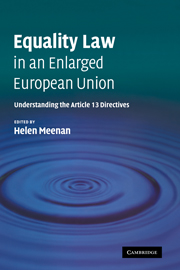Book contents
- Frontmatter
- Contents
- Preface
- Acknowledgements
- List of contributors
- Abbreviations
- Table of Cases
- PART I
- PART II
- 5 EU sex equality law post-Amsterdam
- 6 EU anti-racism policy; the leader of the pack?
- 7 Religion or belief; aiming at the right target?
- 8 Disability discrimination law in the European Union
- 9 Age discrimination – Of Cinderella and The Golden Bough
- 10 The ‘mainstreaming’ of sexual orientation into European equality law
- 11 Conclusion
- Index
7 - Religion or belief; aiming at the right target?
Published online by Cambridge University Press: 22 August 2009
- Frontmatter
- Contents
- Preface
- Acknowledgements
- List of contributors
- Abbreviations
- Table of Cases
- PART I
- PART II
- 5 EU sex equality law post-Amsterdam
- 6 EU anti-racism policy; the leader of the pack?
- 7 Religion or belief; aiming at the right target?
- 8 Disability discrimination law in the European Union
- 9 Age discrimination – Of Cinderella and The Golden Bough
- 10 The ‘mainstreaming’ of sexual orientation into European equality law
- 11 Conclusion
- Index
Summary
History and context
The modern continent of Europe has been fashioned by religious conflict. The fifteenth to eighteenth centuries in Europe were characterised by wars of religion, primarily between Catholics and Protestants, although neither sect omitted to persecute the Jews, heretics within their own ranks and anyone else of a different persuasion. At the same time, Western Christendom engaged in an outward-facing war against the Islamic Ottoman Empire and some of what are seen as key moments in European history relate to this struggle. The re-conquest of Granada by the Spanish in 1492 ensured that the lands north of the Mediterranean remained part of the Holy Roman Empire, but in 1453 the Ottoman Turks conquered Constantinople and as late as 1653 they launched a massive operation to take Vienna, an attack ultimately repelled by the Habsburg army. Thus western Europe remained decisively Christian and mainly Roman Catholic. The Balkans remained a maelstrom in the nineteenth century and the collapse of Communism in Yugoslavia in the 1990s brought unspeakable atrocities committed by ethnic groups on each other, their ethnicity generally coextensive with their religious culture.
The European countries who drafted the European Convention on Human Rights and the smaller subset who formed the EEC in the 1950s had largely buried the differences between Catholics and Protestants and saw themselves as an essentially homogeneous community.
- Type
- Chapter
- Information
- Equality Law in an Enlarged European UnionUnderstanding the Article 13 Directives, pp. 202 - 230Publisher: Cambridge University PressPrint publication year: 2007



